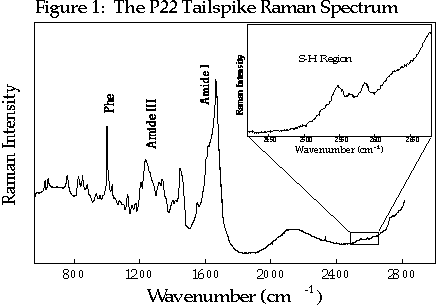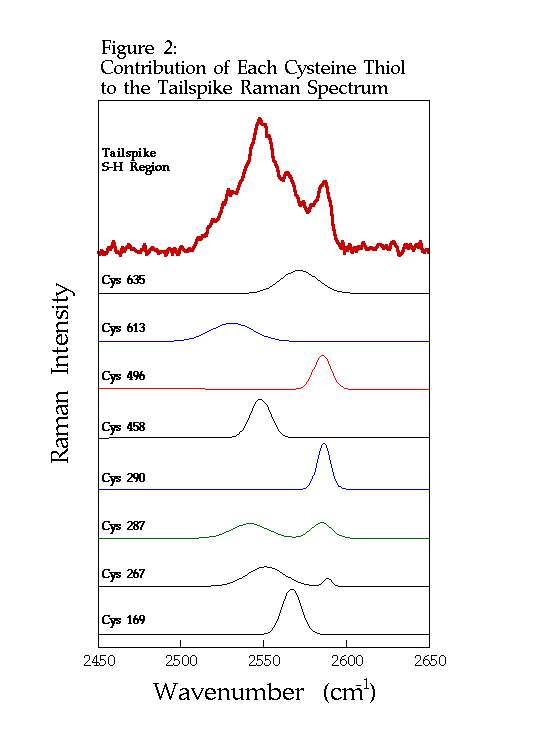
Stephen W. Raso
(in collaboration with Prof. George J. Thomas, Jr., University of
Missouri-Kansas City)
Many proteins contain cysteine residues which are not involved in active sites, ligand binding or disulfide bonds. S-H stretching vibrations generate characteristic Raman bands, which are highly dependent on the environment of the sulfhydryl proton, and represent a valuable method for examining S-H interactions under physiological conditions (1). For the trimeric tailspike protein from bacteriophage P22, all eight cysteine residues (per monomer) are reduced in the native trimer, yet a subset facilitates proper subunit folding and assembly (2). Raman spectroscopy of the tailspike resolves the S-H region of the spectrum into multiple bands, indicating sulfhydryls in several environments (Fig. 1).

Some of the tailspike S-H bands are at extremely low wavenumbers; the band corresponding to one S-H vibration is at 2530 cm-1, a frequency lower than any reported previously. The complex band pattern in this region is diagnostic of the native folded tailspike protein. The Raman spectra of eight Cys to Ser mutant proteins have been analyzed permitting the identification of the specific contribution from each cysteine sulfhydryl to the various S-H bands (Fig. 2).

In addition, the hydrogen bonding environment of each of the eight tailspike cysteines was elucidated (Table 1). Raman spectroscopy provides H-bonding information about the native solution-state of a protein, unlike X-ray crystallographic methods wherein H-bonding interactions are inferred by the interatomic distances of potential H-bond donors and acceptors in the crystalline state.
|
Cysteine Residue |
Raman band (cm-1) |
Proposed H-bonding Strength |
|
169 |
2565 |
Moderately Strong |
|
267 |
2550 (90%) |
Strong |
|
287 |
2550 (63%) |
Strong |
|
290 |
2585 |
Weak/Acceptor |
|
458 |
2550 |
Strong |
|
496 |
2585 |
Weak/Acceptor |
|
a613 |
2530 |
Very Strong |
|
635 |
2576 |
Moderately Weak |
These techniques can be applied to other proteins to study the specific roles cysteine residues in protein structure and function. In addition, S-H Raman markers may be used to probe changes in protein conformation and cysteine oxidation.
References
1. Li, H. & Thomas, G.J., Jr. (1991) J. Am. Chem. Soc. 113, 456-462.
2. Robinson, A.S. & King, J. (1997) Nature Struct. Biol. 4, 450-455.